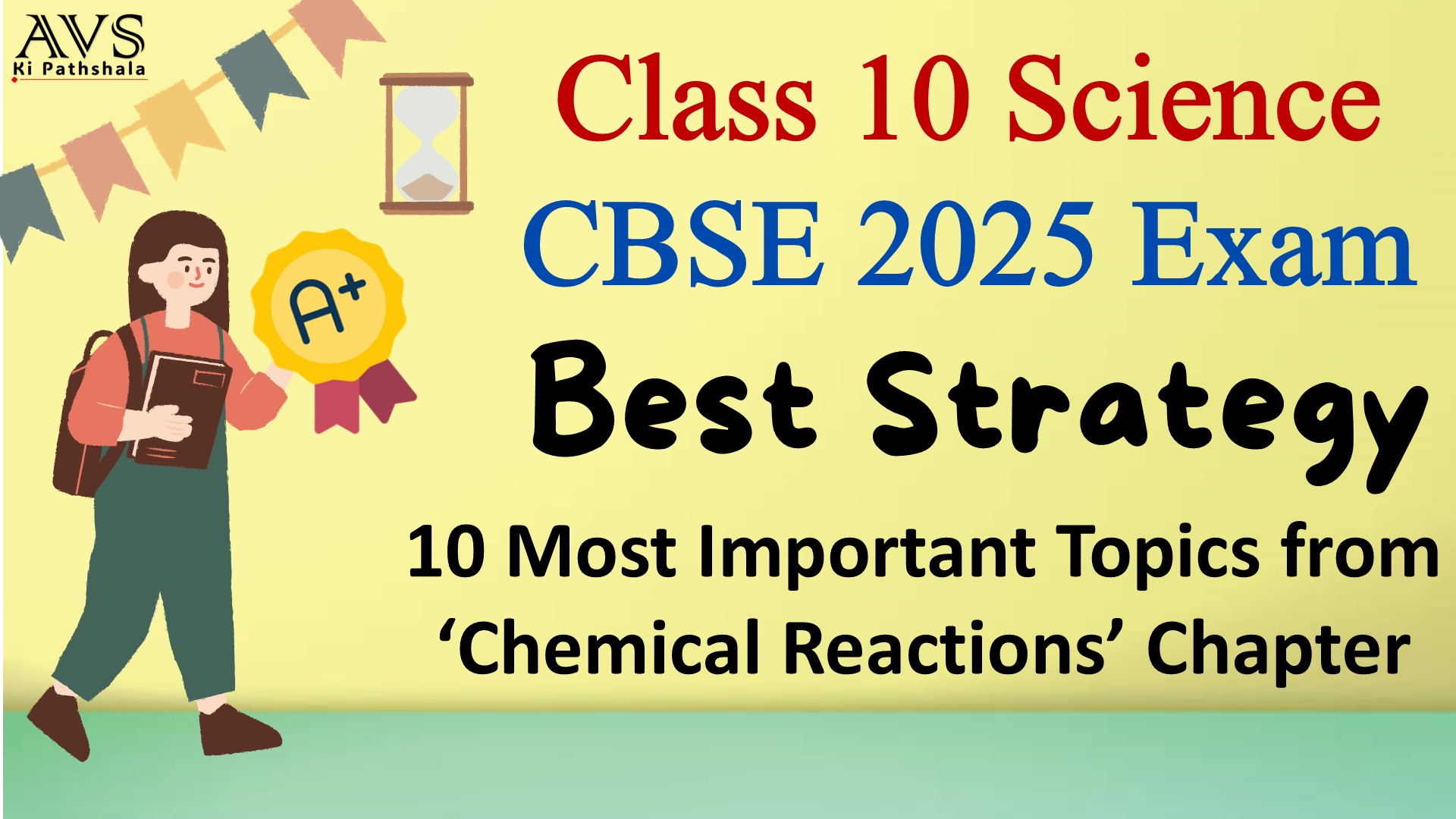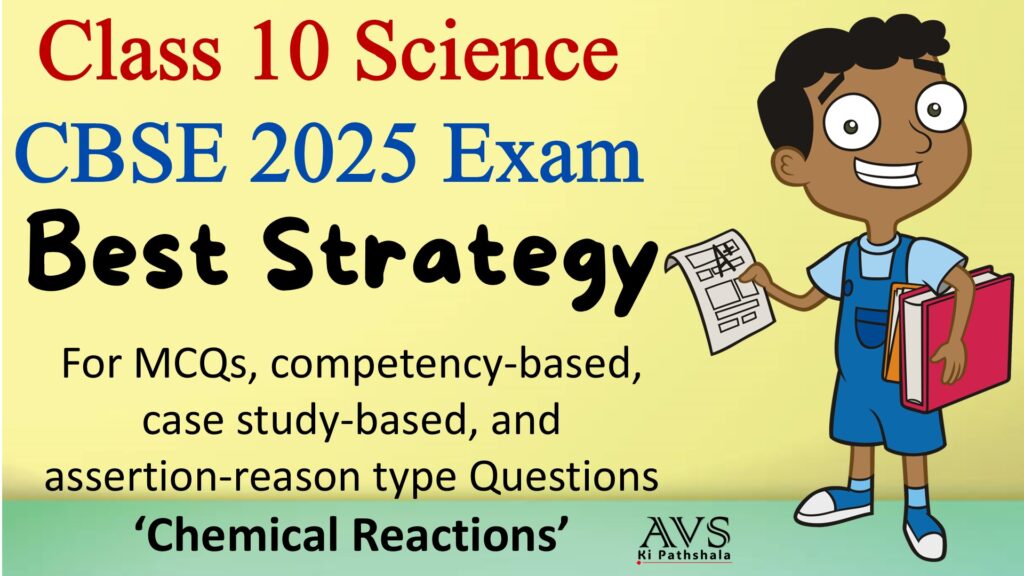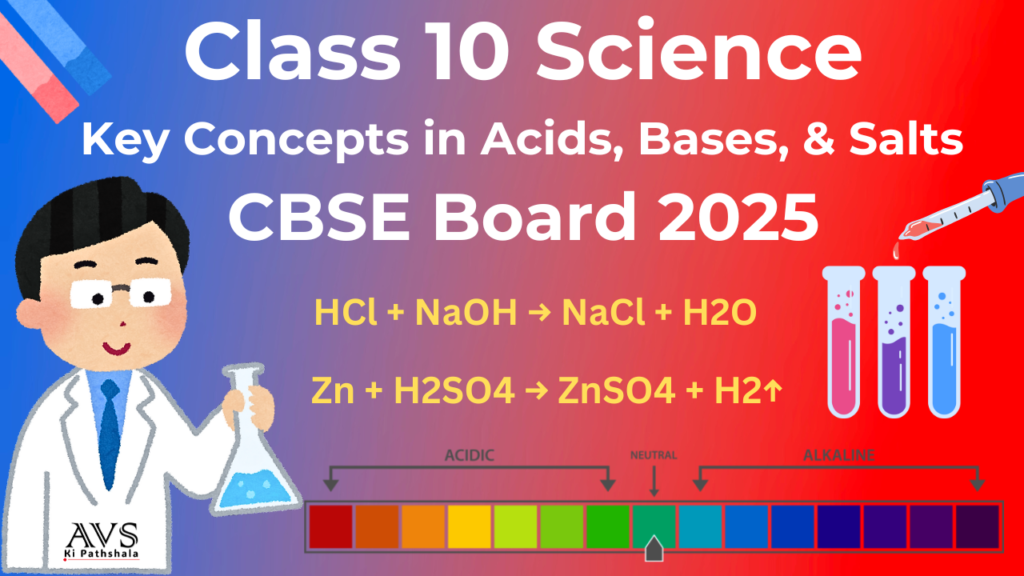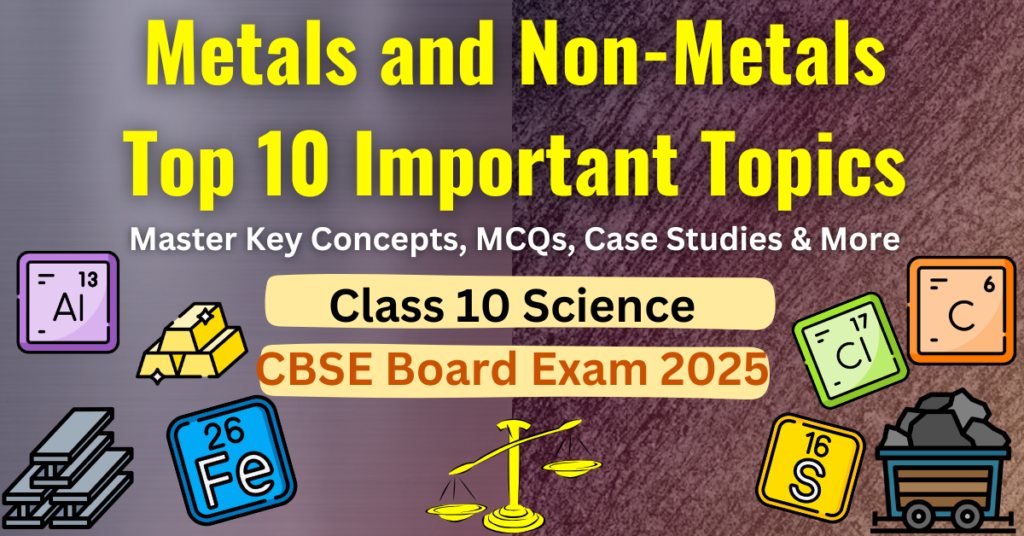Class 10 Science CBSE 2025 Exam
The chapter on Chemical Reactions and Equations in the Class 10 CBSE 2025 syllabus is foundational for understanding the behavior of substances in terms of chemical changes. It is one of the most critical chapters, often comprising a significant portion of the board exam. This chapter explains various types of chemical reactions, their equations, and the laws that govern these transformations.
In this guide, we have analyzed the previous years’ board question papers and predicted the most likely topics and question types for the 2025 CBSE board exams. We will cover important definitions, formulas, and concepts with their expected question patterns.
Top 10 Most Important Topics from ‘Chemical Reactions and Equations’
CBSE Class 10 Science
1. Types of Chemical Reactions
Definition: A chemical reaction is a process in which one or more substances (reactants) are converted into one or more new substances (products).
Sub-types include:
- Combination Reaction
- Decomposition Reaction
- Displacement Reaction
- Double Displacement Reaction
- Redox Reaction
Likely Question Types:
-
- Definition-based questions: Define different types of chemical reactions.
- Short answers: Write balanced chemical equations for combination and decomposition reactions.
- Long answer: Explain displacement and double displacement reactions with examples.
2. Balancing Chemical Equations
Definition:
A chemical equation must have an equal number of atoms of each element on both sides of the reaction. Balancing equations ensures the Law of Conservation of Mass is obeyed.
Likely Question Types:
- MCQs: Identify the correct balanced equation.
- Short answers: Balance given chemical equations.
- Application-based questions: Why is balancing chemical equations important?
3. Oxidation and Reduction (Redox Reactions)
Definition:
- Oxidation: Loss of electrons or gain of oxygen.
- Reduction: Gain of electrons or loss of oxygen.
Redox Reaction Example: ZnO + C → Zn + CO
Likely Question Types:
-
- MCQs: Identify oxidation and reduction components in given reactions.
- Short answers: Explain the concept of redox reactions with examples.
- Concept-based: Explain how oxidation and reduction occur simultaneously.
4. Corrosion and Rancidity
Definition:
- Corrosion: Gradual destruction of metals due to reaction with air, moisture, or chemicals (e.g., rusting of iron).
- Rancidity: Spoilage of oils and fats when exposed to air, causing unpleasant odors and taste.
Likely Question Types:
-
- Short answers: Define corrosion and how it can be prevented.
- Application-based questions: Why do oil-rich foods become rancid?
- Long answer: Discuss methods to prevent corrosion and rancidity.
5. Endothermic and Exothermic Reactions
Definition:
- Endothermic Reaction: Absorbs heat (e.g., melting of ice).
- Exothermic Reaction: Releases heat (e.g., combustion of fuels).
Likely Question Types:
-
- MCQs: Identify the type of reaction based on a given example.
- Short answers: Explain the difference between endothermic and exothermic reactions.
- Long answer: Give examples of both types and explain their energy changes.
6. Precipitation Reactions
Definition:
Precipitation reactions occur when two aqueous solutions combine to form an insoluble solid called a precipitate.
Example: AgNO₃ + NaCl → AgCl (s) + NaNO₃
Likely Question Types:
- MCQs: Identify the precipitate in a given reaction.
- Short answers: What is a precipitation reaction? Give an example.
- Long answer: Explain the process of precipitation and its significance.
7. Effects of Oxidation in Everyday Life
Definition:
Oxidation reactions play a crucial role in daily life, such as causing rust, corrosion, and spoilage of food.
Likely Question Types:
-
- Short answers: Discuss the harmful effects of oxidation.
- Long answer: Explain how oxidation reactions affect food and metals, and how they can be controlled.
8. Activity Series of Metals
Definition:
The activity series is a list of metals arranged according to their reactivity, which helps predict the outcome of displacement reactions.
Likely Question Types:
-
- MCQs: Predict which metal will displace another in a given reaction.
- Short answers: What is the significance of the activity series in displacement reactions?
- Application-based: Use the activity series to justify a reaction.
9. Law of Conservation of Mass
Definition:
The Law of Conservation of Mass states that mass cannot be created or destroyed in a chemical reaction.
Likely Question Types:
-
- MCQs: Identify whether a reaction follows the law.
- Short answers: Explain the Law of Conservation of Mass with an example.
- Long answer: Discuss an experiment that demonstrates the law.
10. Reactivity of Acids and Bases with Metals
Definition:
Acids react with metals to produce salt and hydrogen gas, while bases typically do not react with metals except amphoteric metals like zinc and aluminum.
Likely Question Types:
-
- MCQs: Which metal reacts with acid to produce hydrogen gas?
- Short answers: Write a balanced equation for the reaction of zinc with hydrochloric acid.
- Application-based: Explain the role of reactivity in daily-life applications, such as cleaning agents.
Conclusion:
The chapter on Chemical Reactions is fundamental to understanding the basic concepts of chemistry. The types of reactions, their balancing, and the effects of oxidation are core topics that often appear in exams. To excel in this chapter, it is crucial to have a clear understanding of key definitions, equations, and concepts.
Key Points to Remember:
- Types of Chemical Reactions are highly prioritized in board exams.
- Balancing chemical equations is foundational and always a significant part of questions.
- Oxidation and Reduction concepts are key for understanding redox reactions.
- Corrosion and Rancidity have practical applications and often feature in application-based questions.
- Endothermic and Exothermic Reactions help in understanding energy changes in reactions.
Focus on practicing writing chemical equations, balancing them, and understanding reaction mechanisms to maximize your performance in the CBSE 2025 board exams.
By covering these topics comprehensively and practicing their related questions, students will be well-prepared to tackle both theoretical and application-based questions in the CBSE 2025 Board Exams.
To enhance your preparation even further for CBSE 2025 Exam, you can also connect with us on YouTube, where we will guide you through all these topics in a comprehensive manner. To join us on YouTube, simply click the link below, and you’ve already taken your first step towards scoring better marks.
In the next post, we will discuss the key topics of the chapter ‘Acids, Bases & Salts.’
Note: All the topics covered in this article are based on the “Chemical Reactions and Equations” chapter of Class 10 Science CBSE Board and have been curated after analyzing previous years question papers. This article can be helpful for students aiming for success in exams, but it’s also important to thoroughly understand the entire syllabus and practice regularly.
Best wishes to all students!
Thank you!





